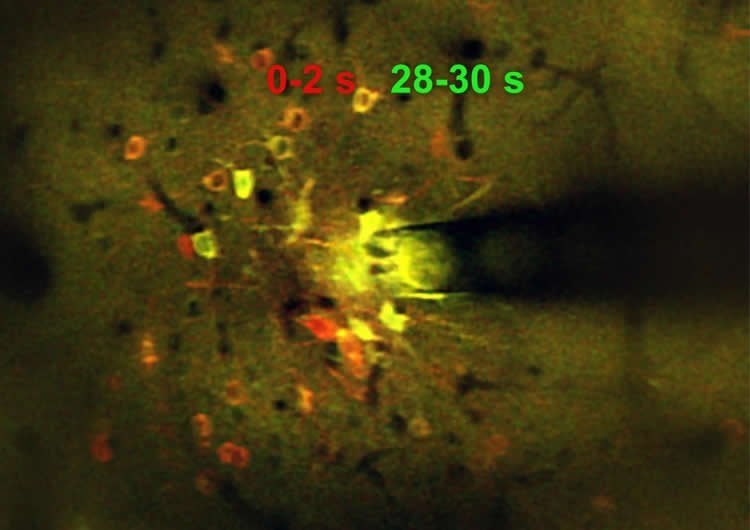Summary: A new study reveals frequency plays a key role in neural activation from electrical stimulation.
Source: University of Pittsburgh.
Electrical stimulation of the brain is common practice in neuroscience research and is an increasingly common and effective clinical therapy for a variety of neurological disorders. However, there is limited understanding of why this treatment works at the neural level. A paper published by Takashi D. Y. Kozai, assistant professor of bioengineering at the University of Pittsburgh Swanson School of Engineering, addresses gaps in knowledge over the activation and inactivation of neural elements that affect the desired responses to neuromodulation.
The article, “Calcium activation of cortical neurons by continuous electrical stimulation: Frequency dependence, temporal fidelity, and activation density”, was published in Neuroscience Research. Co-investigator is Kip Ludwig, associate professor of biomedical engineering at the University of Wisconsin-Madison.
For this study, Kozai’s group – the BIONIC Lab – used in vivo two-photon microscopy to capture neuronal calcium activity in the somatosensory cortex during 30 seconds of continuous electrical stimulation at varying frequencies. They imaged the population of neurons surrounding the implanted electrode and discovered that frequency played a role in neural activation – a finding that conflicted with earlier studies.
“Electrical stimulation has a large number of parameters that can be used to activate neurons, such as amplitude, pulsewidth, waveform shapes, and frequency,” explained Kozai. “This makes it difficult to compare studies because different stimulation parameters are used in other studies. Based on the parameters that were previously employed, it was thought that activation occurs in a sphere centered around the electrode where neurons near the electrode would activate more than neurons far from the electrode.
“Recent research, however, shows that stimulation mostly activates distant neurons whose axons are very close to the electrode by transmitting action potentials backward to the neuron cell body,” he continued. “We demonstrate that both of these things can be true depending on stimulation frequency and duration.”
According to Kozai, the fact that researchers can use varying stimulation parameters to activate different neurons in the same location has huge implications in basic science research. The findings will allow them to activate different neural circuits with the same implant to elicit different behaviors. Beyond its research applications, Kozai believes that this knowledge may also help in clinical settings.

“Empirical evidence in the field suggests that frequency plays a role in deep brain stimulation, but the why and how have puzzled scientists since the beginning,” said Kozai. “This research is a first glimpse into understanding the mechanisms underlying the role of frequency in clinical therapies. In the long-term, this research could also give insight on how to activate distinct glial and vascular populations, which could have a prolonged impact on behavior, attention, and tissue regeneration.”
Kozai believes that more research needs to be done to understand neuronal activation properties and hopes that this work will lead to new tools in neuroscience and improved neuromodulation therapy by explaining why electrical stimulation produces its effective responses.
Source: Leah Russell – University of Pittsburgh
Publisher: Organized by NeuroscienceNews.com.
Image Source: NeuroscienceNews.com image is credited to NJ Michelson & TDY Kozai/BionicLab.
Original Research: Open access research for “Calcium activation of cortical neurons by continuous electrical stimulation: Frequency dependence, temporal fidelity, and activation density” by Nicholas J. Michelson, James R. Eles, Alberto L. Vazquez, Kip A. Ludwig, and Takashi D. Y. Kozai in Journal of Neuroscience Research. Published January 7 2019.
doi:10.1002/jnr.24370
[cbtabs][cbtab title=”MLA”]University of Pittsburgh”How Electrical Stimulation Activates Neurons.” NeuroscienceNews. NeuroscienceNews, 7 January 2019.
<https://neurosciencenews.com/neuron-electrical-stimulation-10469/>.[/cbtab][cbtab title=”APA”]University of Pittsburgh(2019, January 7). How Electrical Stimulation Activates Neurons. NeuroscienceNews. Retrieved January 7, 2019 from https://neurosciencenews.com/neuron-electrical-stimulation-10469/[/cbtab][cbtab title=”Chicago”]University of Pittsburgh”How Electrical Stimulation Activates Neurons.” https://neurosciencenews.com/neuron-electrical-stimulation-10469/ (accessed January 7, 2019).[/cbtab][/cbtabs]
Abstract
Calcium activation of cortical neurons by continuous electrical stimulation: Frequency dependence, temporal fidelity, and activation density
Electrical stimulation of the brain has become a mainstay of fundamental neuroscience research and an increasingly prevalent clinical therapy. Despite decades of use in basic neuroscience research and the growing prevalence of neuromodulation therapies, gaps in knowledge regarding activation or inactivation of neural elements over time have limited its ability to adequately interpret evoked downstream responses or fine‐tune stimulation parameters to focus on desired responses. In this work, in vivo two‐photon microscopy was used to image neuronal calcium activity in layer 2/3 neurons of somatosensory cortex (S1) in male C57BL/6J‐Tg(Thy1‐GCaMP6s)GP4.3Dkim/J mice during 30 s of continuous electrical stimulation at varying frequencies. We show frequency–dependent differences in spatial and temporal somatic responses during continuous stimulation. Our results elucidate conflicting results from prior studies reporting either dense spherical activation of somas biased toward those near the electrode, or sparse activation of somas at a distance via axons near the electrode. These findings indicate that the neural element specific temporal response local to the stimulating electrode changes as a function of applied charge density and frequency. These temporal responses need to be considered to properly interpret downstream circuit responses or determining mechanisms of action in basic science experiments or clinical therapeutic applications.







